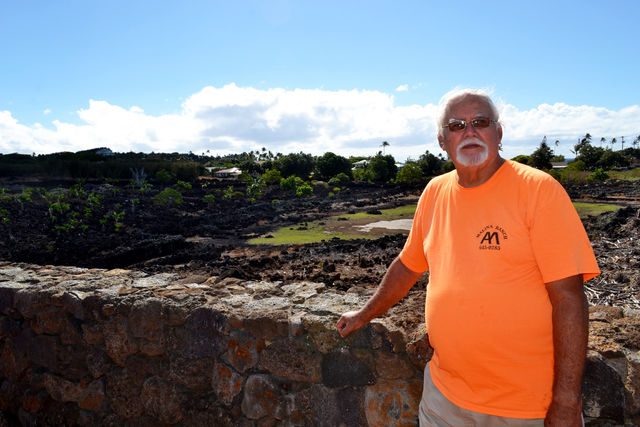POIPU — Rupert Rowe says the Kaneiolouma heiau complex in Poipu represents the storied history of Hawaii.
“If you don’t understand Hawaii’s past, you’ll never have a future,” said Rowe, po‘o (head) for Hui Malama O Kaneiolouma, a nonprofit organization in charge of restoring and stewarding the 13-acre Native Hawaiian complex. “By showing the past and understanding the past, it’s much easier to focus on this energy.”
The 15-year project, which began in late 2012, is in the third phase of the restoration, Rowe said.
Added to Ke Kahua O Kaneiolouma earlier this month was the completion of a public viewing platform and walkway that includes informative interpretive signs in Hawaiian and English.
Five signs in total outline information on Henry Kekahuna, the Hawaiian surveyor who mapped the Kaneiolouma complex in 1959; the Polynesian triangle; the Hawaiian moon calendar; Kauai’s heritage; and the history of the restoration project.
Rowe said Alexander & Baldwin floated a $875,000 grant for the restoration that funded the $800,000 rock wall that surrounds the site as well as an estimated $50,000 for the costs and installation of the interpretive signs, paths, access and viewpoints.
“We’re now in our third phase, which is raising up money and the restoration on the inside,” he said. “We’ll put back house sites, walls, fish ponds and try to make this place the way Henry Kekahuna described it.”
Rowe estimated that the remainder of costs for the restoration, which is slated to be completed in about a decade, will be about $2 million.
“We have Native American grants we can qualify for, cultural grants, and big companies we can apply for whatever they have in their foundation,” Rowe said. “I have six months for put all my things together for next year.”
Dating back to the mid-13th century, Ke Kahua O Kaneiolouma was a hub for cultivation, housing, religious ceremonies, sporting events, and festivals.
The goals of the project are to preserve Hawaiian culture through restoration, honor and respect the site while enhancing education and recreational opportunities at Poipu, and provide a link to Hawaiian traditions and heritage through expanded knowledge and experience of cultural practices.
“It means the opportunity for the kanaka and the keiki to be able to reconnect with their culture and be able to have a site that the education for the future generations will be invaluable,” said John Spaar, a caretaker for Kaneiolouma and member of Hui Malama O Kaneiolouma for about a decade.
Working on cleaning out the area Monday through Wednesday, Spaar said about 15 people meet once a month on Sunday to help with restoration.
“I was a little overwhelmed with the work that had been done, but it was just the energy that’s in there,” he said. “The more that you would clean, the more that it would open up and the more that it would breathe and come back to life. That would always would give you enough energy to want to come right back the next day to keep at it.”
Spaar said the group has planted 13 varieties of native trees, four varieties of palms, three varieties of coconuts and a dozen ground plants.
“Once the trees get established and once we get full-time caretakers that can be here to water, then we’ll put up more of the smaller herbs that need a lot more tending than what I can keep up with right now,” he said. “In the future, (the number of plants) can be innumerable. It can have any Hawaiian herb we can find and cultivate and plant in here.”
Antonio Kenji, a visitor from Los Angeles, said he was impressed by the progress that was made since his visit last year.
“Next year, I hope to see the plants start to grow and flourish for locals and for tourists to see what Hawaii was all about,” he said.
Lisa Sherrard, of Santa Cruz, said she visits at least once a year and has witnessed the site’s progress.
“We remember not so many years ago when it was not like this,” he said. “It’s a really good thing to see. No resorts on this land.”
Rowe said Hui Malama O Kaneiolouma received the stewardship agreement with the county in 2010 and opened up the site in 2013.
“We have five more times we’re going to clean all that koa,” he said. “By April 2017, you’re going to see right through.”
Moving Forward, Rowe said, the nonprofit is concentrating to build a cultural interpretive visitor center in the near future.
“This whole function of this facility can be very productive,” he said. “This whole thing became an economic stimulus for the Southside. As you can see, you know the generation of interest because everybody wants to know about Hawaii.”







